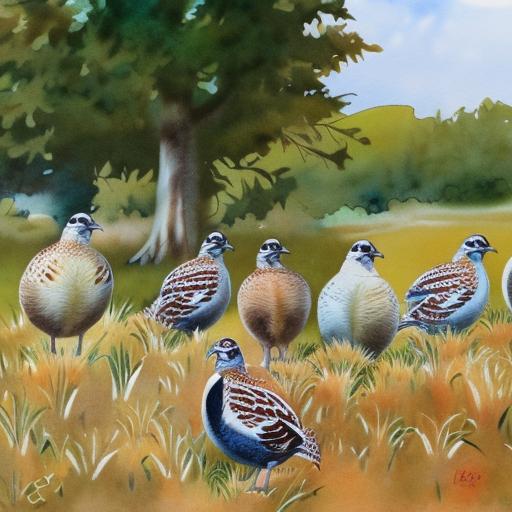Quail farming has gained popularity in recent years due to the high demand for their meat, which is considered a delicacy in many parts of the world. Quail are small, ground-dwelling birds that are known for their fast growth and high meat-to-bone ratio, making them an ideal choice for meat production. There are several quail breeds that are specifically bred for meat production, each with its own unique characteristics and advantages. In this article, we will explore some of the top quail breeds for meat production, including the Coturnix quail, Jumbo Coturnix quail, Bobwhite quail, Pharaoh quail, and A&M quail. We will discuss the key features of each breed and provide insights into their suitability for meat production.
Key Takeaways
- Quail breeds are a popular choice for meat production due to their small size and fast growth rate.
- Coturnix quail is the top choice for meat production due to its high meat-to-body ratio and fast maturity.
- Jumbo Coturnix quail is a larger alternative to standard Coturnix quail, offering more meat per bird.
- Bobwhite quail is a popular game bird with potential for meat production, known for its flavorful meat.
- Pharaoh quail is a hardy and productive breed for meat, known for its adaptability and high egg production.
- A&M quail is a hybrid breed known for its meat production, offering a balance of size and meat quality.
- When choosing the best quail breed for meat production, consider factors such as size, growth rate, and adaptability to your specific environment.
Coturnix Quail: The Top Choice for Meat Production
Coturnix quail, also known as Japanese quail, are one of the most popular breeds for meat production due to their fast growth, high egg production, and excellent meat quality. These small birds reach maturity in just 6-8 weeks and can be harvested for meat shortly thereafter. Coturnix quail are known for their tender, flavorful meat with a high meat-to-bone ratio, making them a favorite among quail farmers and consumers alike. They are also relatively easy to raise, requiring minimal space and maintenance compared to other livestock. Additionally, Coturnix quail come in a variety of color mutations, including standard brown, white, tuxedo, and silver, making them an attractive choice for farmers looking to add visual appeal to their quail farm.
Another advantage of Coturnix quail is their high egg production, with hens laying up to 300 eggs per year. This dual-purpose nature makes them a cost-effective option for farmers looking to maximize their returns from both meat and egg production. Furthermore, Coturnix quail are known for their docile nature, making them easy to handle and manage, even for beginners. Overall, Coturnix quail are an excellent choice for meat production due to their fast growth, high meat-to-bone ratio, dual-purpose nature, and ease of management.
Jumbo Coturnix Quail: A Larger Alternative for Meat Production
For farmers looking for a larger alternative to standard Coturnix quail, Jumbo Coturnix quail are an excellent choice for meat production. As the name suggests, Jumbo Coturnix quail are larger in size compared to standard Coturnix quail, making them a preferred option for those seeking a bigger yield of meat per bird. These birds reach maturity in 8-10 weeks and can be harvested for their tender, flavorful meat. Jumbo Coturnix quail also exhibit high egg production, with hens laying up to 300 eggs per year, making them a dual-purpose breed suitable for both meat and egg production.
In addition to their larger size and high egg production, Jumbo Coturnix quail share many of the same advantages as standard Coturnix quail, including ease of management, docile nature, and minimal space requirements. Their fast growth and high meat-to-bone ratio make them an attractive option for farmers looking to maximize their meat yield while minimizing feed and space requirements. Overall, Jumbo Coturnix quail are an excellent choice for meat production due to their larger size, high egg production, and ease of management.
Bobwhite Quail: A Popular Game Bird with Meat Production Potential
Bobwhite quail are a popular game bird native to North America that also have potential for meat production. These small birds are known for their distinctive call and are often hunted for sport, but they also offer excellent meat quality with a rich, gamey flavor. While Bobwhite quail may not grow as quickly as Coturnix quail, they are still a viable option for meat production, reaching maturity in 10-12 weeks. Their meat is lean and flavorful, making it a sought-after delicacy in many culinary circles.
In addition to their meat production potential, Bobwhite quail are also known for their adaptability to various climates and environments, making them a hardy choice for farmers in different regions. They are also relatively easy to raise and can thrive in both enclosed pens and free-range settings. While Bobwhite quail may not lay as many eggs as Coturnix quail, they still offer a respectable egg yield, making them a dual-purpose breed suitable for both meat and egg production. Overall, Bobwhite quail are a popular game bird with great potential for meat production due to their rich, gamey meat flavor, adaptability to different environments, and dual-purpose nature.
Pharaoh Quail: A Hardy and Productive Breed for Meat
Pharaoh quail, also known as wild-type Coturnix quail, are a hardy and productive breed that is well-suited for meat production. These small birds are named after their wild-type coloration, which closely resembles the plumage of wild quail species. Pharaoh quail reach maturity in 6-8 weeks and can be harvested for their tender, flavorful meat with a high meat-to-bone ratio. They are also known for their high egg production, with hens laying up to 300 eggs per year, making them a dual-purpose breed suitable for both meat and egg production.
In addition to their fast growth and high egg production, Pharaoh quail are known for their adaptability to various environments and resistance to common poultry diseases. They are relatively low-maintenance birds that require minimal space and can thrive in both enclosed pens and free-range settings. Their docile nature makes them easy to handle and manage, even for beginners. Overall, Pharaoh quail are a hardy and productive breed that is well-suited for meat production due to their fast growth, high egg production, adaptability to different environments, and ease of management.
A&M Quail: A Hybrid Breed Known for its Meat Production

A&M quail are a hybrid breed created by crossing two different strains of Coturnix quail – the Texas A&M University strain and the random-bred strain. This hybridization has resulted in a breed that is specifically bred for meat production with excellent growth rates and high meat yield. A&M quail reach maturity in 6-8 weeks and can be harvested for their tender, flavorful meat with a high meat-to-bone ratio. They are also known for their high egg production, with hens laying up to 300 eggs per year, making them a dual-purpose breed suitable for both meat and egg production.
In addition to their fast growth and high egg production, A&M quail exhibit many of the same advantages as standard Coturnix quail, including ease of management, docile nature, and minimal space requirements. Their hybrid vigor also makes them more resistant to common poultry diseases compared to purebred strains. Overall, A&M quail are a hybrid breed known for its excellent meat production characteristics due to its fast growth, high egg production, hybrid vigor, and ease of management.
Conclusion and Considerations for Choosing the Best Quail Breed for Meat
In conclusion, there are several quail breeds that are well-suited for meat production, each with its own unique characteristics and advantages. Coturnix quail and its variations are popular choices due to their fast growth, high meat-to-bone ratio, dual-purpose nature, and ease of management. Bobwhite quail offer rich, gamey-flavored meat with adaptability to different environments. Pharaoh quail are hardy birds with fast growth rates and high egg production. A&M quail are a hybrid breed specifically bred for excellent meat production characteristics.
When choosing the best quail breed for meat production, farmers should consider factors such as growth rate, meat quality, egg production, adaptability to different environments, resistance to diseases, ease of management, and space requirements. Ultimately, the best breed will depend on the specific needs and preferences of the farmer. Whether it’s the fast-growing Coturnix quail or the rich-flavored Bobwhite quail, there is a breed suitable for every farmer’s meat production goals. With careful consideration and proper management practices, raising quail for meat can be a rewarding endeavor with the potential for high returns.
If you’re interested in raising quail for meat, you might also want to check out this article on how to insulate a chicken coop to ensure your quail are kept in the best possible conditions for optimal growth and health. Proper insulation can help regulate the temperature inside the coop, which is crucial for raising healthy quail for meat production.
FAQs
What are the best quail breeds for meat production?
The best quail breeds for meat production are the Coturnix (also known as Japanese quail) and the Bobwhite quail. These breeds are known for their fast growth, high meat-to-bone ratio, and overall suitability for meat production.
What makes Coturnix and Bobwhite quail ideal for meat production?
Coturnix and Bobwhite quail are ideal for meat production due to their rapid growth rate, reaching maturity in as little as 6-8 weeks. They also have a high meat-to-bone ratio, making them efficient for meat production.
Are there other quail breeds suitable for meat production?
While Coturnix and Bobwhite quail are the most popular for meat production, other breeds such as the Jumbo Coturnix and Pharaoh quail can also be raised for meat. However, they may not grow as quickly or have as high of a meat-to-bone ratio as the Coturnix and Bobwhite quail.
What should I consider when choosing a quail breed for meat production?
When choosing a quail breed for meat production, consider factors such as growth rate, meat-to-bone ratio, feed efficiency, and adaptability to your specific climate and environment. It’s also important to consider the availability of breeding stock and the market demand for the specific breed in your area.
Are there specific management practices for raising quail for meat production?
Yes, specific management practices such as providing a balanced diet, proper housing, and disease prevention are important for raising quail for meat production. It’s also important to consider humane and ethical practices when raising quail for meat.
Meet Walter, the feathered-friend fanatic of Florida! Nestled in the sunshine state, Walter struts through life with his feathered companions, clucking his way to happiness. With a coop that’s fancier than a five-star hotel, he’s the Don Juan of the chicken world. When he’s not teaching his hens to do the cha-cha, you’ll find him in a heated debate with his prized rooster, Sir Clucks-a-Lot. Walter’s poultry passion is no yolk; he’s the sunny-side-up guy you never knew you needed in your flock of friends!







